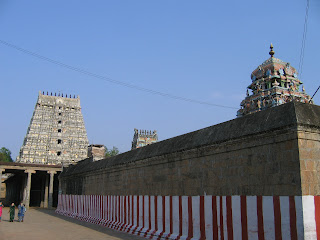Chariot Festival at temples in Tamil Nadu this Chitrai has not gone as per plan. And the one that took place last Friday (4May) at the Swayambu Kshetram of Bhoo Varaha Swamy temple in Srimushnum was no different.
By 630am on Friday morning, the Utsava deity Lord Yagya Varahaswamy, along with Sri Devi and Bhoo Devi, was all set for the one day trip on the Chariot. However, it turned out to be a longer day out in the Sun with the unexpected turn of events on Friday.
Starting at 8am, seated atop the
chariot, Yagya Varahaswamy began his trip around the four Mada Streets of Sri
Mushnam. While he was expected to be
back at the Garuda Mandapa at the temple by the same evening, a slip of the
huge chariot at one of the Mada Streets meant that the Lord had to remain in
the sweltering 40degree heat for well over 24hours.
It was only by 2pm on Saturday
that the chariot was back at the Garuda Mandapa, where one witnessed a special
Thiruvanthi Kaapu Vaibhavam. Later, on
Saturday evening, Special abhisheka was performed at the Ahobila Mutt. After a
special Alankara, Lord Yagya Varahaswamy made his way from the Ahobila Mutt to
the Hanuman temple before reaching his sanctum to bring to end a rather tense
Chariot Festival.
A speciality of the Chariot Festival at Srimushnam is that Chariot has a Muslim flag, a symbol of the Hindu- Muslim Unity. In fact, every year in Maasi, the Utsava deity goes on a 20 day procession to Killai and other nearby villages near Chidambaram. An interesting feature of the festival in Maasi is that the Muslims in the area offer prasadams to the Lord Yagya Varaha and they take back the flower of the Lord and offer it to Allah. The Muslim devotees are said to thank Allah for having brought Varaha Swamy to their place. Bhoo Varaha Swamy temple in Srimushnum is the only temple that brings together such unity between Muslims and Hindus and this event continues to take place to this day.
Unlike typical moolavar deities
in Vishnu temples, the Lord here is in the form of a small idol signifying the
Varaha Avatar.
Worried that people may turn away
from here because of the Lord’s pig face, Bhoodevi requested him to display his
handsome stature. Answering her prayers, the Utsava idol features here as Yagya
Varahaswamy with a conch and chakra.
Swayambu
Kshetram
Srimushnum is one of the 8
Swayambu Kshetrams in India. The others are Srirangam, Tirupathi and
Vanamaamalai (Nanguneri) in South India and Saligramam, Naimisarinyam,
Pushkaram and Badri in North India. The speciality of the Bhoo Varaha Perumal is
that there is a Thirumanjana every day for the Saligrama idol.
Lord’s
Five Fingers
While the moolavar idol is a Swayambu moorthy, the
temple itself is believed to have been constructed by Four Nayak kings-
Achuthappa, Ananthappa, Govindappa and Kondappa Nayak. The story goes that
Ananthappa Nayak developed severe stomach pain when they camped at
Rajendrapatnam, 8kms East of Sri Mushnum. He was relieved of his pains when
Lord Vishnu appeared in his dreams and touched his stomach. Delighted at this,
he came here and constructed the temple. To this day, one can see the five
fingers of the Lord below his left stomach.
The Pushkarani at the temple was
created with the sweat emanating from the Lord’s body after his battle with Hiranyaksha. Answering Hiranyaksha’s final wish, Bhoo
Varaha Swamy turned towards is direction facing South. To this day, the body
bearing a human shape is facing West in the direction of the devotees
Inscriptions




No comments:
Post a Comment